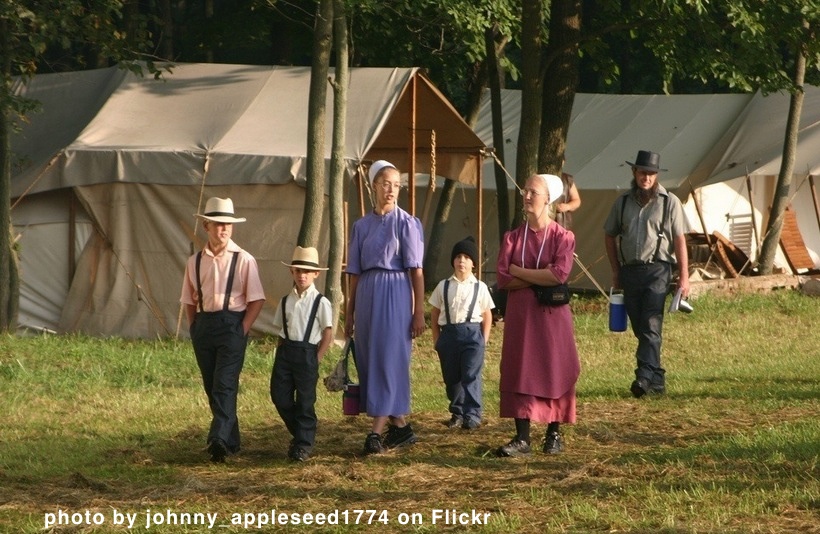A Brief But Informative History of the Amish

Many non-Amish accept the Amish as a not always present but existing part of the American community, but very few know how they got to where they are today and where they came from. If you’re interested in reading (which you should be if you’re looking to date in the Amish community) here is a brief history of the Amish from their origins as the Swedish Brethren to the many varying communities they have today.
In the beginning

Amish Mennonites origins date back to 16th century Germany to a fellowship known as the Swiss Brethren. The Swiss Brethren were Anabaptists, a religion that directly translates to “one who baptizes again”. The Anabaptist belief is that children and infants should not be forced into devoting themselves to a religion so it isn’t right to force baptism onto them when they don’t have a choice.
That’s why in the Amish society, baptism doesn’t occur until adulthood when the person has a chance to choose for themselves whether to devote themselves to the religion or not.
The Amish, who are a branch of the Anabaptist religion, take the name from Jakob Ammann. He was a Swiss Mennonite leader who believed in strict devotion to the church and upheld the practice of shunning totally. He believed that shunning—the practice of ignoring excommunicated members of the faith until they repented and rejoined the church—should be upheld to the point where spouses wouldn’t even eat together if one were to leave the faith.
This brought a split between Mennonites and the ones who sided with Jakob Ammann and his teachings became known as the Amish.
Moving to America
They began migrating over to Pennsylvania during the 18th century to avoid religious wars, poverty, and religious persecution in Europe, and this led to the first Amish immigrants landing in Berks County, Pennsylvania. However, not all immigrants stayed there and eventually the Amish population spread to other parts of the country, like Illinois, Delaware, Alabama, Indiana, Ohio, and many of the other states that contain large parts of the 250,000 strong Amish population.
In fact, this immigration is why Amish communities speak Amish — a form of German—as their native language as well as English. That’s a fun fact many don’t know about.
However, this spread caused a thinning among the population and resulted in large losses within the faith. Many of the established communities lost their identity and assimilated into their surroundings, most famously in the original major split which took place in the 1860s. This huge loss in religious membership necessitated the most famous ministerial conferences in Amish history, all of which took place in Wayne County, Ohio.
These conferences brought together bishops of the faith who then discussed what direction the faith would take and what they would do to curb their losses and protect future communities from assimilation. Up until this point, it was unheard of for bishops to come together and discuss uniformity within the Amish church.
The conferences and present day
Many of the more traditionally minded bishops boycotted the conferences altogether, but two thirds of the conference stuck through and worked together to come to universal solutions. While the conferences themselves were progressive ideas for the religion, the results of the conferences were even more impacting still.
The major agenda of the conference, of course, was the discussion about how the Amish communities could protect themselves from assimilating into the outside world.
The bishops who boycotted the conferences caused a split within the Amish community. This split marked the birth of the Old Order Amish community, or rather the birth of the distinction between the conservative Amish communities and the more progressive. More about the old Amish Order here:
http://amishreligiousfreedom.org/origin.htm
Those who boycotted went back to communities that became known as Old Order Amish while the ones who stayed with the conferences went back to their communities and began programs like Sunday school and other non-traditional Amish practices.
Today, there are eight subgroups of the Amish church, though they can all be organized into the following six denominations: Beachy Amish Mennonite, New Order Amish, Old Order Amish, Swartzentruber Amish, Troyer Amish, and the Tobe Church.
Dating and relationships
As someone who is looking to date within the Amish community, knowing the differences in the histories of each community is integral to successfully dating. Each community leads a different lifestyle and the “why and how” for each can be drawn back to the splits within the Amish church that formed them. From various traditions like the way they raise families to how they handle teenage and 2o something dating you will find differences in each of the communites. When you date an Amish person you are also dating their upbringing, their community, and their history. More on Amish dating and relationship customers can be read at the following link:
http://www.lucistree.com/amish-dating-and-relatioship-customs/
Family, community and religion are found at the core of every baptized member of the Amish community, meaning that by researching and learning a bit about each community can give you better insight into where you are most likely to find an Amish person that fits your personality.




